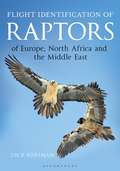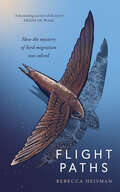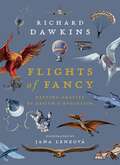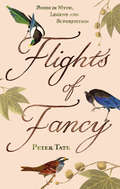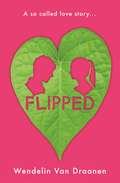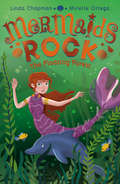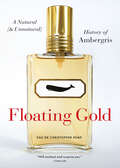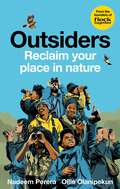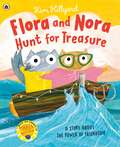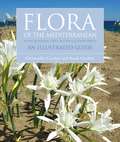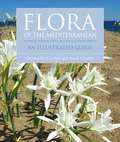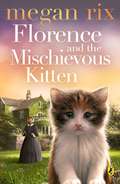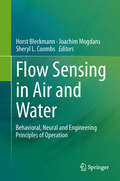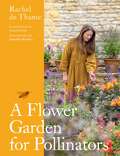- Table View
- List View
Flight Identification of Raptors of Europe, North Africa and the Middle East
by Dick ForsmanRaptors are notoriously hard to identify, even if seen well, and represent perhaps the toughest of all ID challenges for birders. This book is the ultimate flight-identification guide for the raptors of the Western Palaearctic, covering Europe, North Africa, the Middle East (including Arabia) to Central Asia. It provides identification information for all 60 species that regularly occur in the region, to subspecific level. The text covers every plumage and age in detail, with each species account accompanied by a range of photographs covering all the principal plumages.Based on this stunning photographic coverage, most of which has never been published before, this book represents a landmark in bird identification books and a major work for all raptor enthusiasts.
A Flight of Butterflies
by Kanzaka SekkaExquisite full-color plates depict 216 winged beauties, soaring and drifting across the pages in apparently seamless flight. Also includes a bonus CD-ROM that features all of the royalty-free butterfly graphics, both in full "flights" and separated into individual units. Ideal for lovers of fine art and for use by graphic artists, designers, and craftworkers.
Flight of Mammals: From Terrestrial Limbs to Wings
by Aleksandra A. Panyutina Leonid P. Korzun Alexander N. KuznetsovThis book offers a new explanation for the development of flight in mammals and offers detailed morphological descriptions of mammals with flapping flight. The skeletomuscular apparatus of the shoulder girdle and forelimbs of tree shrews, flying lemurs and bats is described in detail. Special attention is paid to the recognition of peculiar features of the skeleton and joints. For the basic locomotor patterns of flying lemurs and bats, the kinematic models of the shoulder girdle elements are developed. The most important locomotor postures of these animals are analyzed by means of statics. The key structural characters of the shoulder girdle and forelimbs of flying lemurs and bats, the formation of which provided transition of mammals from terrestrial locomotion to gliding and then, to flapping flight, are recognized. The concept is proposed that preadaptations preceding the acquisition of flapping flight could have come from widely sprawled forelimb posture while gliding from tree to tree and running up the thick trunks. It is shown that flying lemur is an adequate morphofunctional model for an ancestral stage of bats. The evolutionary ecomorphological scenario describing probable transformational stages of typical parasagittal limbs of chiropteran ancestors into wings is developed.
Flight Paths: How the mystery of bird migration was solved
by Rebecca HeismanHow and why birds navigate the skies, travelling from continent to continent — flying thousands of miles across the earth each autumn and spring — has continually fascinated the human imagination, but only recently have we been able to fully understand these amazing journeys. How did this revolution come about? Flight Paths is the never-before-told story of how an eccentric group of ornithologists, engineers and other pioneering scientists have harnessed nearly every technological development of the last hundred years to understand bird migration in detail - from where and when they take off, their flight paths and behaviours, their destinations and the challenges they face getting there. In this fascinating and compelling story Rebecca Heisman uncovers the secret history of an ornithological arms race that not only helped solve the mystery of bird migration using radar, radioactive isotopes, satellites and the humble aluminium band but has also given us much needed insight into how best to protect and conserve the bird life we cherish.
Flights of Fancy: Defying Gravity by Design and Evolution
by Richard DawkinsRichard Dawkins on how nature and humans have learned to overcome the pull of gravity and take to the skies. 'A masterly investigation of all aspects of flight, human and animal... A beautifully produced book that will appeal across age groups' Alexander McCall Smith 'Dawkins has always been an extraordinarily muscular, persuasive thinker. What feels new here is that he writes with such charm and warmth' The TimesHave you ever dreamt you could fly? Or imagined what it would be like to glide and swoop through the sky like a bird? Do you let your mind soar to unknown, magical spaces? Richard Dawkins explores the wonder of flight: from the mythical Icarus, to the sadly extinct but spectacular bird Argentavis magnificens, from the Wright flyer and the 747, to the Tinkerbella fairyfly and the Peregrine falcon. But he also explores flights of the mind and escaping the everyday – through science, ideas and imagination. Fascinating and beautifully illustrated, this is a unique collaboration between one of the world's leading scientists and a talented artist.
Flights of Fancy: Birds in Myth, Legend and Superstition
by Peter TateDid you know that Barnacle geese were once classified as fish? That both the Cherokees and the ancient Greeks were convinced that cranes regularly fought battles with pygmies? That the Swiss believed that any cuckoo that managed to survive for a year would turn into an eagle?Throughout history, birds have fascinated and intrigued mankind, so it is hardly surprising that an astonishingly rich body of myth, legend and superstition has grown up around them. Flights of Fancy explores the stories told about 30 of the world's best-known species, from the blackbird to the wryneck, drawing on traditions from every quarter of the globe. Some of the stories included clearly arose as a result of faulty observation, such as the widely held belief that nightjars sucked milk from cows. Others stemmed from attempts to explain unusual aspects of appearance or behaviour. But the vast majority seem to have their origins in people's delight in inventing stories - whether the legend that the blackbird was originally white, or the suggestion that witches kept owls as their familiars. And, as Peter Tate points out, what is so extraordinary is that the same story often crops up in many different parts of the world: the belief that eagles and snakes are sworn enemies can be found as far apart as Iraq and Mexico; the view that the raven is the harbinger of bad luck can be found throughout Europe from Denmark to Spain.A fascinating and wonderfully entertaining read, this is the ideal book for anyone interested in birds or myths - or both.
Flipped
by Wendelin Van DraanenAS SEEN ON NETFLIX.A classic he-said-she-said romantic comedy, with bonus content including a Q&A with the author.All I've ever wanted is for Juli Baker to leave me alone. For her to back off – you know, just give me some space.Juli has been making Bryce's life hell from the moment they met. All he wants is to live a normal life, without some crazy person mooning after him.The first day I met Bryce Loski, I flipped. Honestly, one look at him and I became a lunatic. It's his eyes.But she doesn't see it that way. In her eyes, they're meant for each other, even though he might not realize it yet.That is, until the eighth grade, when everything flips. And just as Juli starts to realize that Bryce may not be all he seemed, Bryce begins to think that there's more to Juli than meets the eye . . . Wendelin Van Draanen's Flipped is a modern-day classic about first love and not judging a book by it's cover. A romantic comedy-of-errors told in alternating chapters by two fresh, funny voices.
The Floating Forest (Mermaids Rock #2)
by Linda ChapmanWelcome to Mermaids Rock! The entrance to the mermaid realm in the deep, blue ocean… Coralie is overjoyed when she visits a beautiful kelp forest, where she meets adorable sea lions and otters and finds a mysterious treasure map! After telling her friends about it, they're excited to search for the treasure, but when they arrive they find the forest has been destroyed. With no protection from the plants, the animals are in danger, and the friends must do everything they can to save the creatures before it’s too late… From the author of STAR FRIENDS comes the second book in a delightful new series about the wonders of the ocean, perfect for fans of RAINBOW MAGIC, Barbie Dolphin Magic and Holly Webb.
Floating Gold: A Natural (and Unnatural) History of Ambergris
by Christopher Kemp“Preternaturally hardened whale dung” is not the first image that comes to mind when we think of perfume, otherwise a symbol of glamour and allure. But the key ingredient that makes the sophisticated scent linger on the skin is precisely this bizarre digestive by-product—ambergris. Despite being one of the world’s most expensive substances (its value is nearly that of gold and has at times in history been triple it), ambergris is also one of the world’s least known. But with this unusual and highly alluring book, Christopher Kemp promises to change that by uncovering the unique history of ambergris. A rare secretion produced only by sperm whales, which have a fondness for squid but an inability to digest their beaks, ambergris is expelled at sea and floats on ocean currents for years, slowly transforming, before it sometimes washes ashore looking like a nondescript waxy pebble. It can appear almost anywhere but is found so rarely, it might as well appear nowhere. Kemp’s journey begins with an encounter on a New Zealand beach with a giant lump of faux ambergris—determined after much excitement to nothing more exotic than lard—that inspires a comprehensive quest to seek out ambergris and its story. He takes us from the wild, rocky New Zealand coastline to Stewart Island, a remote, windswept island in the southern seas, to Boston and Cape Cod, and back again. Along the way, he tracks down the secretive collectors and traders who populate the clandestine modern-day ambergris trade. Floating Gold is an entertaining and lively history that covers not only these precious gray lumps and those who covet them, but presents a highly informative account of the natural history of whales, squid, ocean ecology, and even a history of the perfume industry. Kemp’s obsessive curiosity is infectious, and eager readers will feel as though they have stumbled upon a precious bounty of this intriguing substance.
Flock Together: Connecting people of colour to nature – AS SEEN ON TV
by Nadeem Perera Ollie OlanipekunAS SEEN ON BBC ONE'S THE ONE SHOW'Nature is a universal resource. For too long Black, Brown and people of colour have felt unwelcome and marginalised in spaces that should be for everyone.' -Flock TogetherNature is a powerful source of creativity, inspiration and healing; however, it has not always felt like a safe space for people of colour. Flock Together is here to change that, by inspiring everyone, regardless of race, religion or economic status, to build their relationship with the outdoors and embrace all that nature has to offer.Founded by Ollie Olanipekun and Nadeem Perera in summer 2020, Flock Together is the UK's first birdwatching collective for people of colour. Ollie and Nadeem share a mutual love of nature - it is their outlet when faced with neglect and prejudice, it is a place for deep thought and discovery, and it is the foundation on which their friendship and community is built. Part memoir, part manifesto, Outsiders is Flock Together's call-to-action. Divided into six parts, each chapter focuses on a key pillar in the Flock's mission:1. Make Nature a Must explores the contrast between urban and rural lifestyles. How does the urban environment disconnect the individual from nature? How is nature beneficial to us all? 2. Challenging Preconceptions shows the complexities people of colour face when they are stereotyped. How can we change these preconceptions? 3. Nature as My Healer assesses the systemic issues impacting the mental health of people of colour. How can nature help mitigate this? 4. Building a Community offers guidance to building your own community. How can a community bring systemic change? 5. Who Runs Nature? outlines what we can do to benefit nature. How do communities around the world cooperate with the ecosystem and how can this be introduced more to the western world? 6. Creative Mentorship looks at the obstacles young people of colour face when shut out of particular spaces. How does mentorship help reclaim those spaces?
Flora and Nora Hunt for Treasure: A story about the power of friendship
by Kim HillyardA NEW sea-faring adventure from the award-winning Kim Hillyard!Flora and Nora are a pair of adventurous sea-faring cats. As they sail off in search of The Secret Treasure, a storm hits, destroying their boat and leaving the best friends separated at sea!Will Flora and Nora remember the value of their friendship or will they get carried away with the lure of adventure and jewels?Flora and Nora at Sea is a perfect bedtime read for fans of Rob Biddulph, Rachel Bright and Jim Field.Also available from Kim Hillyard:Mabel and the Mountain: a story about believing in yourselfNed and the Great Garden Hamster Race: a story about kindnessGretel The Wonder Mammoth: a story about overcoming anxiety
Flora of the Mediterranean: An Illustrated Guide
by Christopher Gardner Basak GardnerThe Mediterranean – a land of blues skies, warm sunshine, rugged mountains and azure seas. Yet this familiar image conceals another Mediterranean – a secret landscape populated by a dazzling variety of wild flowers and plants, from spectacular orchids and ancient olive trees to delicate snowdrops and hardy cacti. Following on from their widely acclaimed Flora of the Silk Road, Chris and Basak Gardner present a stunning selection of 600 of the finest wild flowers that grow in the Mediterranean regions of the world. Travelling across five continents – Europe, North America, Africa, South America and Australia – the authors reveal the rich botanical profusion that makes up the flora of the Mediterranean regions of the world. For each region, a succession of the most outstanding flowers is featured, from the spectacular and exotic to the beautiful yet familiar, with each plant presented in its natural habitat. Beginning with the countries of the Mediterranean Basin, the reader is taken along the rugged Atlas Mountains, through Andalucía and Italy, to arrive at the amazing botanical richness of Greece, southern Anatolia and Jordan. In California and Chile the journey is through flowering deserts, snow-capped peaks and towering forests of redwood and monkey puzzle trees, beside a coast lapped by the Pacific Ocean. The ancient landscapes of Southern Australia provide a truly remarkable assemblage of astonishing flora, whilst the Western Cape of South Africa is home to an unimaginable diversity of flora. The accompanying text provides descriptions of the species, plant families and their distribution, as well as offering guidance to those wishing to photograph plants in the wild. With 600 stunning colour photographs, and presenting a breadth of flora never before brought together in a single volume, the authors offer a unique window on the floral wonders of the Mediterranean world.
Flora of the Mediterranean: An Illustrated Guide
by Christopher Gardner Basak GardnerThe Mediterranean – a land of blues skies, warm sunshine, rugged mountains and azure seas. Yet this familiar image conceals another Mediterranean – a secret landscape populated by a dazzling variety of wild flowers and plants, from spectacular orchids and ancient olive trees to delicate snowdrops and hardy cacti. Following on from their widely acclaimed Flora of the Silk Road, Chris and Basak Gardner present a stunning selection of 600 of the finest wild flowers that grow in the Mediterranean regions of the world. Travelling across five continents – Europe, North America, Africa, South America and Australia – the authors reveal the rich botanical profusion that makes up the flora of the Mediterranean regions of the world. For each region, a succession of the most outstanding flowers is featured, from the spectacular and exotic to the beautiful yet familiar, with each plant presented in its natural habitat. Beginning with the countries of the Mediterranean Basin, the reader is taken along the rugged Atlas Mountains, through Andalucía and Italy, to arrive at the amazing botanical richness of Greece, southern Anatolia and Jordan. In California and Chile the journey is through flowering deserts, snow-capped peaks and towering forests of redwood and monkey puzzle trees, beside a coast lapped by the Pacific Ocean. The ancient landscapes of Southern Australia provide a truly remarkable assemblage of astonishing flora, whilst the Western Cape of South Africa is home to an unimaginable diversity of flora. The accompanying text provides descriptions of the species, plant families and their distribution, as well as offering guidance to those wishing to photograph plants in the wild. With 600 stunning colour photographs, and presenting a breadth of flora never before brought together in a single volume, the authors offer a unique window on the floral wonders of the Mediterranean world.
Floral Biology: Studies on Floral Evolution in Animal-Pollinated Plants
by David G. Lloyd Spencer C.H. BarrettStudies in floral biology are largely concerned with how flowers function to promote pollination and mating. The role of pollination in governing mating patterns in plant populations inextricably links the evolution of pollination and mating systems. Despite the close functional link between pollination and mating, research conducted for most of this century on these two fundamental aspects of plant reproduction has taken quite separate courses. This has resulted in suprisingly little cross-fertilization between the fields of pollination biology on the one hand and plant mating-system studies on the other. The separation of the two areas has largely resulted from the different backgrounds and approaches adopted by workers in these fields. Most pollination studies have been ecological in nature with a strong emphasis on field research and until recently few workers considered how the mechanics of pollen dispersal might influence mating patterns and individual plant fitness. In contrast, work on plant mating patterns has often been conducted in an ecological vacuum largely devoid of information on the environmental and demographic context in which mating occurs. Mating-system research has been dominated by population genetic and theoretical perspectives with surprisingly little consideration given to the proximate ecological factors responsible for causing a particular pattern of mating to occur.
Florence and the Mischievous Kitten
by Megan RixThe brilliant new book from Megan Rix, telling the story of Florence Nightingale through the eyes of her young ward. Florence loved cats, and had many during her lifetime. This is the perfect introduction to the Lady with the Lamp for young children, told with warmth, humour and adorable animals.Summer 1888: In a fancy house in London, a kitten called Scamp escapes through an open window and finds himself lost in the middle of the city. Across Hyde Park, a young girl called Beth is marching with thousands of other girls to protest the working conditions in the Bryant and May match factories.When Beth stumbles across the tiny kitten she finds that he belongs to none other than Miss Florence Nightingale, who is now indebted to Beth for returning her beloved pet. So begins an unlikely friendship between the great lady, her mischievous kitten, and Beth the penniless orphan.But when Beth's sister Iris is struck down with illness in one of the poorest parts of London, can Beth, Scamp and Miss Nightingale find a way to save her before it's too late?
Florentine and Pig and the Lost Pirate Treasure
by Eva KatzlerWhen Florentine and Pig find themselves stuck inside on a rainy day, they decide to think of something fun to do . . . And what could be more fun than searching for lost pirate treasure? Ooo arr, me hearties!Join Florentine and Pig as they sail the seven seas (yo ho ho!), explore the Lost Treasure Island (shiver me timbers!) - and even find time to snuffle a tasty treat or two from their picnic hamper . . . But will they find the treasure?Includes delicious recipes and craft ideas to make every rainy day an exciting pirate adventure!Brilliantly read by Katy Ashworth. Please note that audio is not supported by all devices, please consult your user manual for confirmation.
Florentine and Pig Have A Very Lovely Picnic
by Eva KatzlerTwo best friends + lots of fun in the kitchen = one perfectly delightful sunny picnic!Including recipes and more from the story so you can have a picnic of your own, just like Florentine and Pig!Brilliantly read by Katy Ashworth. Please note that audio is not supported by all devices, please consult your user manual for confirmation.
Florida Manatees: Biology, Behavior, and Conservation
by John E. Reynolds IIIManatees, the gentle giants of Florida's lagoons and coastal habitats, can bring a smile to the face of anybody lucky enough to spy one. As manatees dip and roll through the water, crowds gather to watch them feed on aquatic vegetation. Whether they are congregating by the hundreds or resting or feeding alone, viewing these sea cows can provide anyone interested in nature with hours of tranquil pleasure.Having survived for eons, today's manatees are now under constant threat due to our rapidly swelling human population. Their habitats are often devastated by development and pollution. The slow-moving manatees also live at the mercy of chance, for they occupy waters filled with fast-moving boats powered by razor-sharp propellers;¢;‚¬;€?a new form of predator from which they have no protection. Boat speed limits have been put in place to protect manatees, but there is a constant push to lift them so that people can once again zip across the waters that manatees call home. For this reason, manatees are often a subject of controversy that pits their lives against the rights of boat owners. In this book, manatee expert John E. Reynolds III and famed photographer Wayne Lynch join forces to reveal the clearest portrait of manatees ever published. Florida Manatees is a song for the manatee, a celebration of the lives of these majestic creatures. Reynolds's concise, informative text shares what scientists know about manatees, while Lynch's beautiful photographs instantly demonstrate how special these "potatoes with whiskers" really are. By encouraging an appreciation of manatees, the authors hope to help ensure a future in which Floridians can find ways to coexist with and continue to enjoy these uniquely wonderful sirenian inhabitants of their state.Included in this book: How manatees first came to Florida waters How manatees fit into the ecosystems of Florida What and how much manatees eat How manatees behave and communicate with one another Why manatees look the way they do Why manatees have whiskers How manatee mothers feed their young and much more
Florida Manatees: Biology, Behavior, and Conservation
by John E. Reynolds IIIManatees, the gentle giants of Florida's lagoons and coastal habitats, can bring a smile to the face of anybody lucky enough to spy one. As manatees dip and roll through the water, crowds gather to watch them feed on aquatic vegetation. Whether they are congregating by the hundreds or resting or feeding alone, viewing these sea cows can provide anyone interested in nature with hours of tranquil pleasure.Having survived for eons, today's manatees are now under constant threat due to our rapidly swelling human population. Their habitats are often devastated by development and pollution. The slow-moving manatees also live at the mercy of chance, for they occupy waters filled with fast-moving boats powered by razor-sharp propellers;¢;‚¬;€?a new form of predator from which they have no protection. Boat speed limits have been put in place to protect manatees, but there is a constant push to lift them so that people can once again zip across the waters that manatees call home. For this reason, manatees are often a subject of controversy that pits their lives against the rights of boat owners. In this book, manatee expert John E. Reynolds III and famed photographer Wayne Lynch join forces to reveal the clearest portrait of manatees ever published. Florida Manatees is a song for the manatee, a celebration of the lives of these majestic creatures. Reynolds's concise, informative text shares what scientists know about manatees, while Lynch's beautiful photographs instantly demonstrate how special these "potatoes with whiskers" really are. By encouraging an appreciation of manatees, the authors hope to help ensure a future in which Floridians can find ways to coexist with and continue to enjoy these uniquely wonderful sirenian inhabitants of their state.Included in this book: How manatees first came to Florida waters How manatees fit into the ecosystems of Florida What and how much manatees eat How manatees behave and communicate with one another Why manatees look the way they do Why manatees have whiskers How manatee mothers feed their young and much more
The Florida Scrub Jay (MPB-20), Volume 20: Demography of a Cooperative-Breeding Bird. (MPB-20)
by Glen Everett Woolfenden John W. FitzpatrickFlorida Scrub Jays are an excellent example of a cooperative-breeding species, in which adult birds often help raise offspring not their own. For more than a decade Glen E. Woolfenden and John W. Fitzpatrick studied a marked population of these birds in an attempt to establish a demographic base for understanding the phenomenon of "helping at the nest." By studying both population biology and behavior, the authors found that habitat restraints, rather than kin selection, are the main source of the behavior of Florida Scrub Jays: the goal of increasing the number of close relatives other than descendants in future generations is of relatively minor importance in their cooperative-breeding behavior. The Florida Scrub Jay lives only in the Florida oak scrub. All acceptable habitat is constantly filled with breeders. Each year about half of the pairs are assisted by one to several nonbreeding helpers. This book provides extensive data on fecundity, survivorship, relatedness, and dispersal to establish the demographic milieu and to address questions arising out of observed helping behavior--whom, how, when, and why the helpers help.
The Florida Scrub Jay: Demography of a Cooperative-Breeding Bird. (MPB-20) (Monographs in Population Biology #112)
by Glen Everett Woolfenden John W. FitzpatrickFlorida Scrub Jays are an excellent example of a cooperative-breeding species, in which adult birds often help raise offspring not their own. For more than a decade Glen E. Woolfenden and John W. Fitzpatrick studied a marked population of these birds in an attempt to establish a demographic base for understanding the phenomenon of "helping at the nest." By studying both population biology and behavior, the authors found that habitat restraints, rather than kin selection, are the main source of the behavior of Florida Scrub Jays: the goal of increasing the number of close relatives other than descendants in future generations is of relatively minor importance in their cooperative-breeding behavior. The Florida Scrub Jay lives only in the Florida oak scrub. All acceptable habitat is constantly filled with breeders. Each year about half of the pairs are assisted by one to several nonbreeding helpers. This book provides extensive data on fecundity, survivorship, relatedness, and dispersal to establish the demographic milieu and to address questions arising out of observed helping behavior--whom, how, when, and why the helpers help.
Flow Control Through Bio-inspired Leading-Edge Tubercles: Morphology, Aerodynamics, Hydrodynamics and Applications
by Daniel T. H. New Bing Feng NgThis book describes and explains the basis of bio-inspired, leading-edge tubercles based on humpback whale flippers as passive but effective flow control devices, as well as providing a comprehensive practical guide in their applications. It first discusses the morphology of the humpback whale flipper from a biological perspective, before presenting detailed experimental and numerical findings from past investigations by various experts on the benefits of leading-edge tubercles and their engineering implementations.Leading-edge tubercle designs and functions have attracted considerable interest from researchers in terms of understanding their role in the underwater agility of these whales, and to exploit their flow dynamics in the development of new and novel engineering solutions. Extensive research over the past recent years has demonstrated that the maneuverability of these whales is at least in part due to the leading-edge tubercles acting as passive flow control devices to delay stall and increase lift in the post-stall regime. In addition to the inherent benefits in terms of aerodynamics and hydrodynamics, investigations into leading-edge tubercles have also broadened into areas of noise attenuation, stability and industrial applications.This book touches upon these areas, with an emphasis upon the effects of lifting-surface types, flow regimes, tubercle geometries, lifting-surface stability and potential industrial applications, among others. As such, it features contributions from key experts in the fields of biology, physics and engineering who have conducted significant studies into understanding the various aspects of leading-edge tubercles. Given the broad coverage and in-depth analysis, this book will benefit academic researchers, practicing engineers and graduate students interested in tapping into such a unique but highly functional flow control strategy.
Flow Sensing in Air and Water: Behavioral, Neural and Engineering Principles of Operation
by Horst Bleckmann Joachim Mogdans Sheryl L. CoombsIn this book, leading scientists in the fields of sensory biology, neuroscience, physics and engineering explore the basic operational principles and behavioral uses of flow sensing in animals and how they might be applied to engineering applications such as autonomous control of underwater or aerial vehicles.Although humans possess no flow-sensing abilities, countless aquatic (e.g. fish, cephalopods and seals), terrestrial (e.g. crickets and spiders) and aerial (e.g. bats) animals have flow sensing abilities that underlie remarkable behavioral feats. These include the ability to follow silent hydrodynamic trails long after the trailblazer has left the scene, to form hydrodynamic images of their environment in total darkness, and to swim or fly efficiently and effortlessly in the face of destabilizing currents and winds.
A Flower Garden for Pollinators: Learn how to sustain and support nature with this practical planting guide
by Rachel de ThameThe perfect guide for any gardener looking for inspiration on how to create a pollinator-friendly garden all year round.Pollinators are essential to life on Earth. Yet bees, butterflies and other beneficial insects are struggling due to climate change and habit loss. Fortunately, what we choose to plant in our gardens can help them to thrive. In this heartfelt guide, horticulturalist and Gardener's World presenter Rachel de Thame highlights plants we can grow that are rich in nectar and pollen, ensuring the garden is filled with beautiful flowers for us all to enjoy year-round.Arranged by season and illustrated with exquisite hand-painted watercolours and glorious photography showcasing many of Rachel's favourite plants, this book provides a captivating look at how best to support nature. Whether you have a small urban courtyard or a large country garden, A Flower Garden for Pollinators will guide your choice of plants, attracting a host of pollinators to your own patch of paradise.'A wonderful journey through the magical world of plants.' - Frances Tophill
The Flower Yard: Growing Flamboyant Flowers in Containers – THE SUNDAY TIMES BESTSELLER
by Arthur ParkinsonThe Times Best Gardening Books of the Year 2021'The Flower Yard is simply gorgeous. Inspirational, sumptuous and packed with refreshingly down-to-earth advice. I love this book.' Nigel Slater'The Kew-trained king of the small-space garden.' GuardianArthur Parkinson's town garden is like a path of pots, a tiny, exposed stage on bricks. Despite its small size, a flower-filled jungle in Venetian tones is grown here each year, in defiance of urbanisation. The plants act like drapes, closing gently as their growth engulfs the front door, from either side of the path, to the buzz of precious bees. This is gardening done entirely in pots, yet on a grand scale that will inspire anyone who wants their doorstep or patio to be a glamorous and lively canvas that nurtures them visually and mentally. From jewel scatterings of crocus, flocks of parrot tulips and scented sweet peas to galaxies of single dahlias, towering giraffes of amaryllises grown inside for winter and endless vases of cut blooms through the seasons. With his bantam hens at his feet, Arthur shares his life, knowledge, flair and influences for planting creatively, all of which combine to create a space that's rich in ever-changing colour and life.
